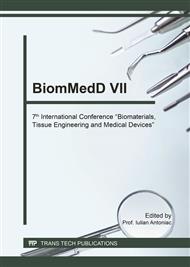p.64
p.71
p.81
p.87
p.93
p.99
p.105
p.111
p.119
Simulation of the Upper Limb Recovery Exercises during Physical Therapy Rehabilitation
Abstract:
During physical therapy rehabilitation, the required exercises need to be personalized according to the patient motion possibilities. The equipment used to analyzed the patient motion is Zebris CMS-HS. With this equipment, for the studied patient, we are able to record the range of motion, angular velocity and acceleration for each joint during different recovery exercises. This records, are the input data for the upper limb model developed in MatLab Simulink software. Using this application is possible to determined the influence of some external forces that are applied during the studied recovery exercises. In this way is possible to established the direction and the maximum value for the external forces that can be applied. Based on this results, a physiotherapist can adjust the exercises to achieve the best solution for the patient recovery.
Info:
Periodical:
Pages:
93-98
Citation:
Online since:
August 2017
Authors:
Keywords:
Price:
Сopyright:
© 2017 Trans Tech Publications Ltd. All Rights Reserved
Share:
Citation:


